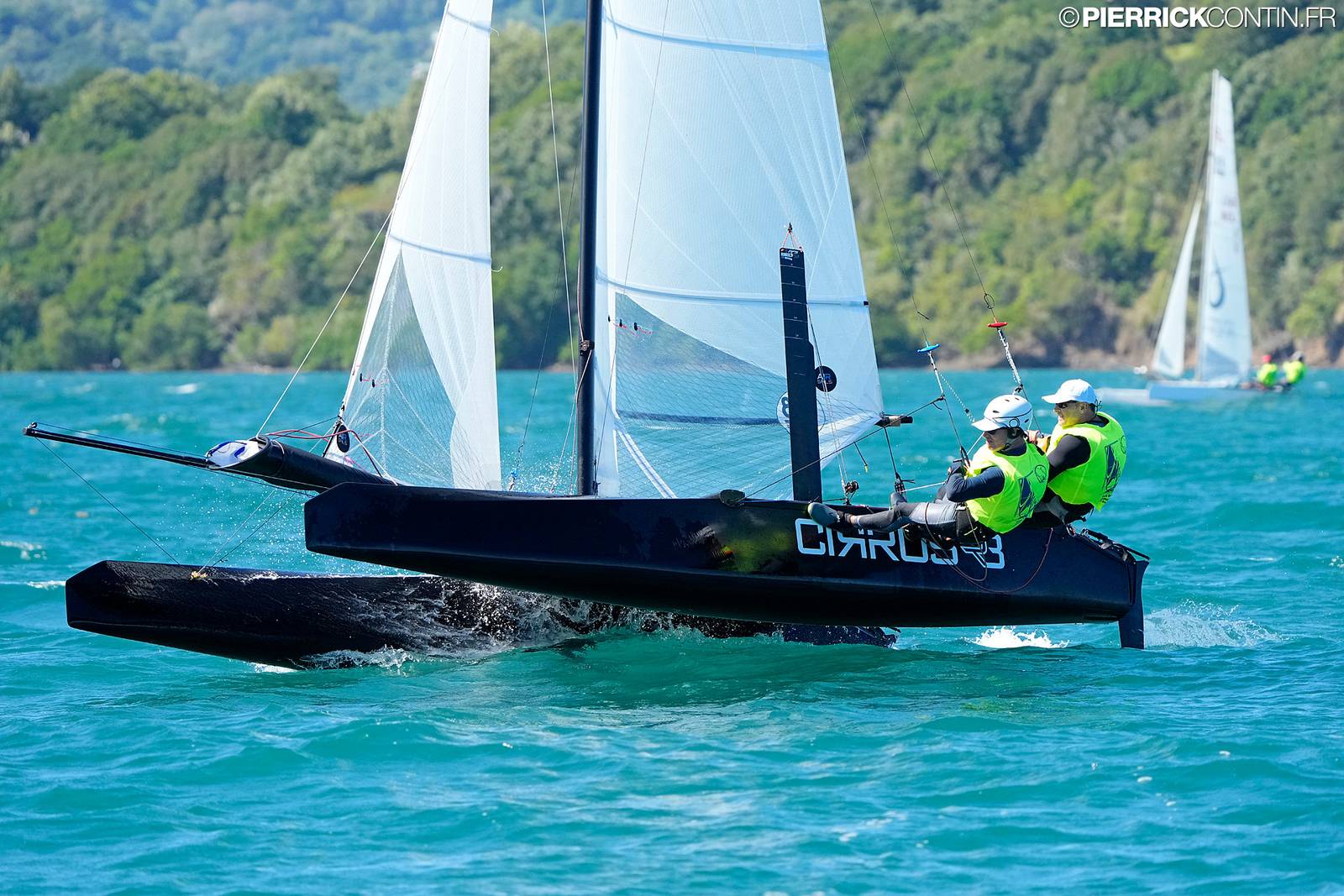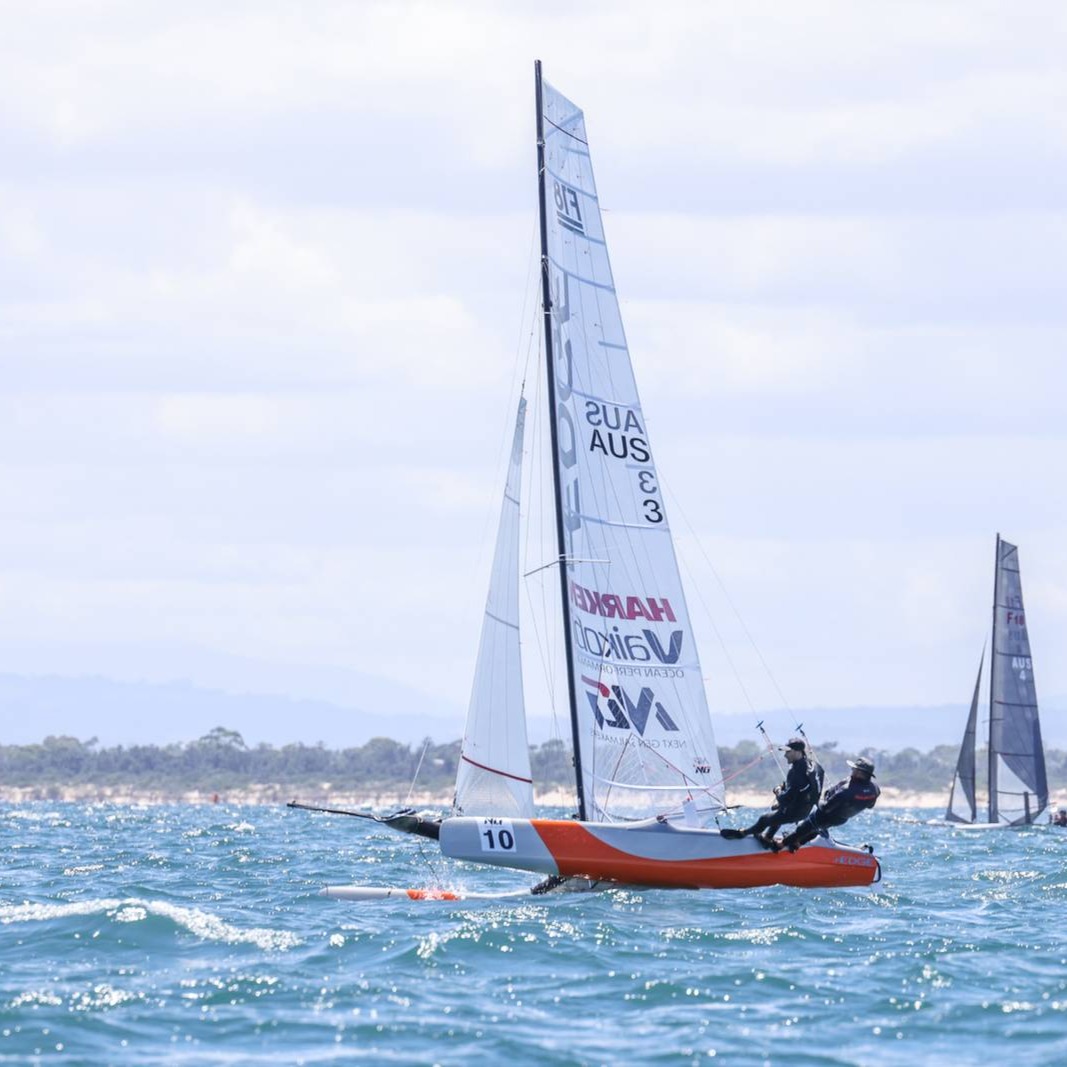Morrelli & Melvin 4pt Foil setup for Nacra 15/17: Q&A with Fer van West
 Pics sent by Ferdinand van West — Some weeks ago Nacra published some renders showing the N15 would be fitted with an A-Class ‘Z’ board foiling solution. The growing adoption of this 4pt foil system is great news for beachcat sailors worldwide, as the 3pt foiling system has the hassle of launching and on the water handling, in contrast they are super efficient in the early foiling and speed aspects.
Pics sent by Ferdinand van West — Some weeks ago Nacra published some renders showing the N15 would be fitted with an A-Class ‘Z’ board foiling solution. The growing adoption of this 4pt foil system is great news for beachcat sailors worldwide, as the 3pt foiling system has the hassle of launching and on the water handling, in contrast they are super efficient in the early foiling and speed aspects.
But latest ‘Z’ board developments and new learned techniques , as seen in the Dna F1 article published past week , are placing the ‘4pt’ board conf in a position to challenge the TNZ J design. In fact a big 55′ cruising cat has already adopted the 4pt foiling setup, I’m waiting for a report & renders to arrive to publish soon on this project.
So the 3pt foil paradigm is being supplanted rather fast, and the guys at Morrelli & Melvin saw it coming and implemented the proven racing A-Class conf with an inhouse design for the Nacra 15 featured above and surely for the Nacra 17* (check Fer’s comments below on the N17) , which was already foiling even with M&M designed curved boards and no rudders winglets.
I think this conf will become the ‘de facto’ system for recreational & racing foilers alike, although from what we’ve seen till now we are still far from the automatic flying of Michele Petrucci’s Stunt 9.
Is important to note that in the racing Multis, asides the mentioned A-Cats, the F20/FP or even AC 45s (Turbo & standard versions) there are no current 4pt challenger. That scenario might change also next season.
Going back to the Nacra 15 I really like now what MM have done with the possibility to fit 3 different foils designs in the same platform, a super clever solution that can be implemented in other cats/classes in the future. This foiling alternative will give dads a reason to buy the 15 ‘for the kids’ for them to go flying single handed.
To know more about M&M / Nacra 15 & 17 foiling projects based on a 4 point foiling setup I contacted naval architect Ferdinand van West, 2x F18 World Champion crew (’14&’15) and currently working in California learning from the Multihull design gurus Gino Morrelli & Pete Melvin at MM offices.
(Like Dna F1 article, this is no ‘press release’, so respect work & copyright and source accordingly when republishing as I do religiously with others.)
——————–
——————–
CSN: You were involved in the first Nacra F20 with curved boards and then later in the Nacra 17 launch/tests. I remember some videos where Macca was getting airborne witht the 20. So It was a surprise for you what the Olympic sailors achieved with the N17 foiling downwind?
Ferdinand van West: It is kind of a surprise they are able to be fully foiling for a brief period of seconds. It does show the level and the skills of the sailors and if you give them a finger, – read: slightly curved symmetrical daggerboard – and they’ll take the whole hand.
– With the standard in the AC and even foiling double handed beachcats being the 3 foil conf, you guys decided to maintain the 4 foils down and take latest A-Class proven concepts like L rudders & Z styled boards for the new Nacra 15. Why?
FVW: Simplified, this configuration moves the “tip-up” effect of the 3-foil configuration (like the Nacra f20 FCS), to the windward CZ-Daggerboard, so both daggerboards need to be down to operate the boat in a stable flight. Which essentially in Full Foiling mode eliminates the daggerboard to be pulled up and down before each manoeuvre making the gybes and tacks significantly easier and less physical for the crew than on the 3 foil configurations equipped boats. So the physical demand of the crew is quite the same as with the curved daggerboard in regards to foil extension, maybe even less.
On the Nacra 17 they seem to pull the windward daggerboard up in most conditions, but with the N15 configuration we expect you will sail with both boards down in most conditions. The choice for L-rudders was one mostly out of safety considerations where you only have the horizontal foil going inboard, but comes with some more benefits as well.
– What can we expect then for the Nacra 15 in terms of foiling?
FVW: Quite the same as the Nacra F20 FCS, but the minimum foilborne true windspeed will be a bit higher on the Nacra 15 and also it will be easier to back off and sail in a non-foiling/semi foiling mode than the Nacra 20 FCS. For example, in conditions with big waves and strong winds, where the L-rudders will provide a lot of pitch stability or safety for the crew.
– Nacra 17 for 2020 has already been voted to be a foiling conf, now we guess that those 15 renders can also preview what updated foils for the N17 would be like?
FVW: The principle will be the same but the final design will be much more refined and quite a bit different. To add to this, we all know about the hype of full foiling, however we also know, having seen dozens of videos and photos, that the current foils on the Nacra 17 already have the ability to lift the entire boat out of the water and hence the structural ability. So these changes to the N17 won’t be that dramatic.
With the proposed update we will alter the daggerboards and rudders such that stable flight is achieved after lifting both hulls out of the water. Besides the shape the manufacturing process of the foils the tooling and joining process will be changed as well to achieve better one-design and quality. Coming back to my first answer it will be very exciting to see how the Olympic sailors will bring this full foiling on beach cats to a much higher level!
– In my experience learning to foil the As having a 4 foils down (and over the top load) simplfiies handling while launching and sailing. The Nacra F20 has a proven racing conf, but can we expect the 4f setup can achieved such stability and speed?
FVW: We believe so, by designing the boards such that there is a leeway-coupling effect between the two surface piercing daggerboards, this effect together with the fluctuating surface area of the foil effected by the flight height makes the boat ‘Heave Stable’.
We have been positively surprised how stable the 4foil configurations with both daggerboards down was in our initial analyses and again when we sailed the first prototype with these daggerboards. This configuration also tends to have a better roll stability which is good, in particular, for trapezing crews. It does come with a drag penalty and the heave force of the windward daggerboard causes a loss in righting moment, which gives the 3-foil configuration still the better VMG performance in the VPP’s. However, the potential of better/quicker tacks and gybes makes it quite an interesting trade-off between these two configurations.
– Do you / MM see 4F being adapted for bigger cats, even AC level? or other beachcats?
FVW: We think so, the benefits of the 4 foiling configurations in terms of boathandling are a big driver and in some case definitely out balances the loss in performance vs the 3 foil configuration. Also for bigger boats, fully foiling with both daggerboards down like the a-cats do isn’t new, have a look at hydroptere and other yachts with a similar setup.
– The Nacra 15 platform will be the same, and it will allow the 3 foils alternatives? Straight , curved, Foiling Why so many versions?
FVW: These different versions just offer better packages for sailing schools & charters in terms of sailing level and financial, the aluminum daggerboards is a significant cost saver for them. The Nacra 15 is designed for a wide range of age, 12-19 years, and levels from starters to the more advanced sailors going to the ISAF youth worlds.
The 3 different daggerboards offer a nice solution to this. We believe this boat will also appeal to adults who want a user-friendly foiling boat at a price that is much lower than other foiling boat solutions.
– The Nacra 15 F version will be sailied in Buenos Aires 2018 Youth Olympics, so we continue to have all the toys here in BA first, when do you expect these version will be available for kids to start sailing/testing them?
FVW: Not sure, hope quite quickly.
– When MM will have the new Olympic N17 platform finished, I assume both project are going side by side at MM design tables? FVW: Yeah they are going side by side and we already build some successful prototypes as you can see in the photos. In cooperation with ISAF the first flying Nacra 17 is set to be launched by end of the summer.
– Besides foils What about overall design for the two platforms, any new devel? Internal structure should be refined for foiling, what about hulls lines? any change?
– It will be interesting to see how MM designs the case solution to support 3 different foils, as in the A.-Class for ie exit of the Z foil have gone outwards , if you pretend to fit a straight board you will have to exit points, as if not you will be losing span for the foils?
FVW: The Nacra 15 will have the daggerboard-case on the hull centerline and for each different daggerboard there will be a different set of daggerboard bearing inserts. These inserts are fitted into the hull by four screws, so they can be easily swapped around. All these particular parts and control systems are mostly designed by Nacra with advice from our side.
– Also interesting to see MM 4 foil design solution without being attached to internal span of the A-Class, are you restricted in any way in the 15 or 17 to achieved desired performance? FVW: No we aren’t restricted to a box rule like the A-class, we are however restricted by; safety considerations, which is kept high on the agenda by ISAF & Nacra, and also always the construction / cost control apply some restrictions to the design.
Which is the performance you got out of the tests done seen in pics above? Can foiling be compared to the F20FCS?? They were ‘long haul’ flughts or jumps? The updated 15 looks like a little weapon now too.
FVW: , Yes the N15 foils as good as the Nacra f20 FCS I would say. So long hauls. Yeah it’s for sure a little weapon and fast too.
– Any other comment or new project for MM you are working etc.
**Copyright Catamaran Racing, News & Design – Do not copy/re publish without naming source clearly: www.catsailingnews.com






























I just heard that my great sailing friend and former CEO of Hobiecat Europe has passed. May The endless oceans…
...Report was sent by an F18 Sailor, if you want Hobies reported send your own, we'll publish as usual. Cheers.
Looks like in your report the Hobies are not really present. Suggest to rewrite the article.
Thanks for the great report Wik. Great battle.
If I correctly read the results the overall winner this year is a Hobie16